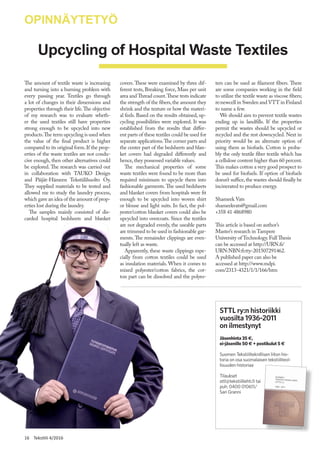
Shameek
- 1. 16 Tekstiili 4/2016 OPINNÄYTETYÖ Upcycling of Hospital Waste Textiles The amount of textile waste is increasing and turning into a burning problem with every passing year. Textiles go through a lot of changes in their dimensions and properties through their life.The objective of my research was to evaluate wheth- er the used textiles still have properties strong enough to be upcycled into new products.The term upcycling is used when the value of the final product is higher compared to its original form.If the prop- erties of the waste textiles are not condu- cive enough, then other alternatives could be explored. The research was carried out in collaboration with TAUKO Design and Päijät-Hämeen Tekstiilihuolto Oy. They supplied materials to be tested and allowed me to study the laundry process, which gave an idea of the amount of prop- erties lost during the laundry. The samples mainly consisted of dis- carded hospital bedsheets and blanket covers.These were examined by three dif- ferent tests, Breaking force, Mass per unit area andThread count.These tests indicate the strength of the fibers,the amount they shrink and the texture or how the materi- al feels. Based on the results obtained, up- cycling possibilities were explored. It was established from the results that differ- ent parts of these textiles could be used for separate applications.The corner parts and the center part of the bedsheets and blan- ket covers had degraded differently and hence,they possessed variable values. The mechanical properties of some waste textiles were found to be more than required minimum to upcycle them into fashionable garments. The used bedsheets and blanket covers from hospitals were fit enough to be upcycled into woven shirt or blouse and light suits. In fact, the pol- yester/cotton blanket covers could also be upcycled into overcoats. Since the textiles are not degraded evenly, the useable parts are trimmed to be used in fashionable gar- ments. The remainder clippings are even- tually left as waste. Apparently, these waste clippings espe- cially from cotton textiles could be used as insulation materials. When it comes to mixed polyester/cotton fabrics, the cot- ton part can be dissolved and the polyes- ters can be used as filament fibers. There are some companies working in the field to utilize the textile waste as viscose fibers; re:newcell in Sweden and VTT in Finland to name a few. We should aim to prevent textile wastes ending up in landfills. If the properties permit the wastes should be upcycled or recycled and the rest downcycled. Next in priority would be an alternate option of using them as biofuels. Cotton is proba- bly the only textile fiber textile which has a cellulose content higher than 60 percent. This makes cotton a very good prospect to be used for biofuels. If option of biofuels doesn’t suffice,the wastes should finally be incinerated to produce energy. Shameek Vats shameekvats@gmail.com +358 41 4868980 This article is based on author’s Master’s research in Tampere University of Technology.Full Thesis can be accessed at http://URN.fi/ URN:NBN:fi:tty-201507291462. A published paper can also be accessed at http://www.mdpi. com/2313-4321/1/1/166/htm STTL ry:n historiikki vuosilta 1936-2011 on ilmestynyt Jäsenhinta 35 e, ei-jäsenille 50 e + postikulut 5 e Suomen Tekstiiliteknillisen liiton his- toria on osa suomalaisen tekstiiliteol- lisuuden historiaa Tilaukset sttl@tekstiililehti.fi tai puh. 0400 010611/ Sari Granni